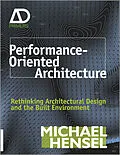Architecture is on the brink. It is a discipline in crisis. Over
the last two decades, architectural debate has diversified to the
point of fragmentation and exhaustion. What is called for is
an overarching argument or set of criteria on which to approach the
design and construction of the built environment. Here, the
internationally renowned architect and educator Michael Hensel
advocates an entirely different way of thinking about architecture.
By favouring a new focus on performance, he rejects longstanding
conventions in design and the built environment. This not only
bridges the gap between academia and practice, but, even more
significantly, the treatment of form and function in design. It
also has a far-reaching impact on knowledge production and
development, placing an important emphasis on design research in
architecture and the value of an interdisciplinary approach.
Though 'performance' first evolved as a concept in
the humanities in the 1940s and 1950s, it has never previously been
systematically applied in architecture in an inclusive manner. Here
Michael Hensel offers Performance-Orientated Architecture as an
integrative approach to architectural design, the built environment
and questions of sustainability. He highlights how core concepts
and specific traits, such as climate, material performance and
settlement patterns, can put architecture in the service of the
natural environment. A wide range of examples are cited to support
his argument, from traditional sustainable buildings, such as the
Kahju Bridge in Isfahan and the Topkapí Palace in Istanbul to
more contemporary works by Cloud 9, Foreign Office Architects,
Steven Holl and OCEAN.
Autorentext
Michael Hensel is an architect, researcher, educator and writer. He is Professor of Architecture at the Oslo School of Architecture and Design where he directs the Research Center for Architecture and Tectonics. He cofounded OCEAN in 1994, and is founding and current chairman of the OCEAN Design Research Association and the Sustainable Environment Association, as well as an editorial board member of Architectural Design (AD). He has co-guest-edited five titles of AD, including seminal issues on emergence and the architecture of Turkey and Iran. He is currently writing The Handbook for Traditional Sustainable Buildings for John Wiley & Sons.
Zusammenfassung
Architecture is on the brink. It is a discipline in crisis. Over the last two decades, architectural debate has diversified to the point of fragmentation and exhaustion. What is called for is an overarching argument or set of criteria on which to approach the design and construction of the built environment. Here, the internationally renowned architect and educator Michael Hensel advocates an entirely different way of thinking about architecture. By favouring a new focus on performance, he rejects longstanding conventions in design and the built environment. This not only bridges the gap between academia and practice, but, even more significantly, the treatment of form and function in design. It also has a far-reaching impact on knowledge production and development, placing an important emphasis on design research in architecture and the value of an interdisciplinary approach.
Though 'performance' first evolved as a concept in the humanities in the 1940s and 1950s, it has never previously been systematically applied in architecture in an inclusive manner. Here Michael Hensel offers Performance-Orientated Architecture as an integrative approach to architectural design, the built environment and questions of sustainability. He highlights how core concepts and specific traits, such as climate, material performance and settlement patterns, can put architecture in the service of the natural environment. A wide range of examples are cited to support his argument, from traditional sustainable buildings, such as the Kahju Bridge in Isfahan and the Topkapí Palace in Istanbul to more contemporary works by Cloud 9, Foreign Office Architects, Steven Holl and OCEAN.
Inhalt
Dedication 005
Acknowledgements 005
Foreword by David Leatherbarrow 009
Introduction: The Task at Hand 015
Chapter 1: A Brief History of the Notion of Performance 017
Chapter 2: A Brief History of the Notion of Performance in Architecture 023
Chapter 3: Non-Discrete Architectures 031
Chapter 4: Non-Anthropocentric Architectures 045
Chapter 5: Traits of Performance-Oriented Architecture 053
Local Climate and Microclimate 057
Material Performance 059
The Active Boundary, the Articulated Envelope and Heterogeneous Environments 067
The Extended Threshold 082
Second-Degree Auxiliarity: Supplementary Architectures 095
First-Degree Auxiliarity: Embedded Architectures 109
Multiple Grounds and Settlement Patterns 116
Chapter 6: The Road(s) Ahead 133
Select Bibliography 143Index 148
Picture Credits 152
